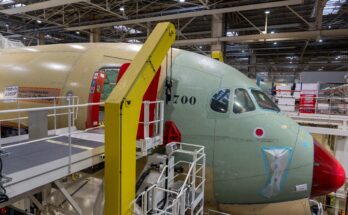By Richard Pettibone, Aerospace & Defense Companies Analyst, Forecast International.
Following its consolidation with Ukraine’s state-owned defense conglomerate Ukroboronprom earlier this year, Antonov is now expected to become the focal point of the country’s aviation industry. In addition, Antonov will expand its maintenance, repair, and operations services under Ukroboronprom’s aegis.
The absorption into Ukroboronprom ends a recent power struggle over who would lead Antonov. Previously, in 2014, the government announced it would oust Antonov’s chairman, Dmytro Kiva. In response, Antonov’s workers marched on Kiev and demanded his reinstatement. In August, an attempt to enter the headquarters of Antonov to gain corporate documents and seals was repulsed. Ultimately, bureaucracy won out and Antonov’s leadership changed, with Mykhaylo O. Gvozdov currently serving as acting president of the firm.
The new ownership has been moving rather rapidly, quietly announcing a new heavy transport, the An-188, at the 2015 Paris Air Show. This new design is aimed at reinvigorating the company’s position in the medium transport aircraft market. Having produced arguably the most transport aircraft of any firm, the move seems logical. However, the company will face competition from Airbus with its A400M. Further, its largest customer for these types of aircraft is Russia – not a welcoming market at the moment.
Antonov has not been spared the effects of the current political turmoil between Ukraine and Russian-supported separatists. The impact of this conflict on the firm was immediate – plans to restart joint production of the Antonov An-124 transport aircraft and to continue development on the An-70 platform were derailed. In addition, Antonov’s supply chain stretched across the troubled Russian border, a factor that continues to hinder the airframer’s progress. Further, plans with Russia’s UAC for marketing and after-sales support for a range of Antonov aircraft have also been put on hold as the conflict wears on.
Overall, the firm’s programs face a difficult outlook, as Russian customers usually account for the bulk of any Antonov orders. Export customers will not buy an aircraft unless it is in service in large numbers in either Ukraine or Russia. With the current conflict only getting worse, production lines at Antonov will slow.
Despite the turmoil, Antonov is attempting to continue operations with as much normalcy as possible. The company is moving ahead on its programs, such as the development of the An-178 freighter prototype. However, until the crisis with Russia is concluded, the outlook for Antonov will remain troubled at best.
A military history enthusiast, Richard began at Forecast International as editor of the World Weapons Weekly newsletter. As the Internet grew in importance as a research tool, he helped design the company's Forecast Intelligence Center and currently coordinates the EMarket Alert newsletters for clients. Richard also manages social media efforts, including two new blogs: Defense & Security Monitor, covering defense systems and international issues, and Flight Plan, which focuses on commercial aviation and space systems. For over 30 years, Richard has authored the Defense & Aerospace Companies, Volume I (North America) and Volume II (International) services. The two books provide detailed data on major aerospace and defense contractors. He also edits the International Contractors service, a database that tracks all the contractors involved in the programs covered in the FI library. More recently he was appointed Manager, Information Services Group (ISG), a new unit that encompasses developing outbound content for both Forecast International and Military Periscope.



